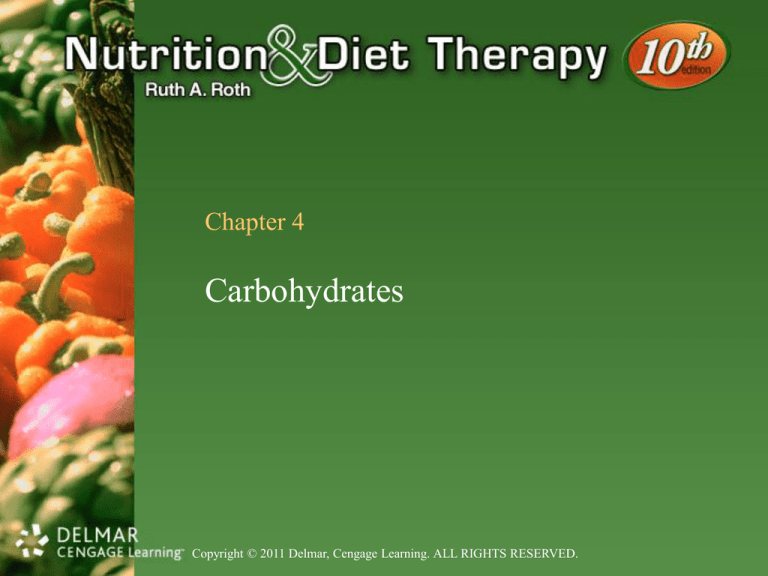
Chapter 4
Carbohydrates
Copyright © 2011 Delmar, Cengage Learning. ALL RIGHTS RESERVED.
Objectives
• Identify functions of carbohydrates
• Name primary sources of carbohydrates
• Describe classification of carbohydrates
Copyright © 2011 Delmar, Cengage Learning. ALL RIGHTS RESERVED.
Facts
• Primary source of energy for body
• Least expensive and most abundant of energy
nutrients
(continues)
Copyright © 2011 Delmar, Cengage Learning. ALL RIGHTS RESERVED.
Facts
• Named for chemical elements that compose
them
– Carbon (C)
– Hydrogen (H)
– Oxygen (O)
Copyright © 2011 Delmar, Cengage Learning. ALL RIGHTS RESERVED.
Functions
•
•
•
•
Provide energy
Spare protein
Maintain normal fat metabolism
Provide fiber
Copyright © 2011 Delmar, Cengage Learning. ALL RIGHTS RESERVED.
Provide Energy
• Each gram of CHO provides 4 calories
• Body needs constant energy supply
• Half-day’s supply of carbohydrates stored in
liver and muscles for use as needed
– Glycogen
• Stored form
Copyright © 2011 Delmar, Cengage Learning. ALL RIGHTS RESERVED.
Spare Protein
• Primary function of proteins:
– Build and repair tissues
• When enough carbohydrates ingested, proteins
spared to be used for their primary function
– At least 50 to 100 g per day
Copyright © 2011 Delmar, Cengage Learning. ALL RIGHTS RESERVED.
Maintain Normal Fat Metabolism
• Without adequate supply of CHO, fat
metabolized to meet energy requirements
• Ketones produced as byproduct of fat
metabolism
• Ketoacidosis may result
Copyright © 2011 Delmar, Cengage Learning. ALL RIGHTS RESERVED.
Stop and Share
• Role-play the following scenario with a
partner:
– A client asks the nurse about starting a high-protein, lowcarbohydrate diet. How should the nurse respond?
(continues)
Copyright © 2011 Delmar, Cengage Learning. ALL RIGHTS RESERVED.
Stop and Share
• Carbohydrates necessary for energy
• Lack of adequate carbohydrate intake can
result in ketoacidosis
– Condition in which acids accumulate in blood
• Ketones
• Protein best used for building and repairing
body tissues
Copyright © 2011 Delmar, Cengage Learning. ALL RIGHTS RESERVED.
Provide Fiber
• Dietary fiber found in grains, vegetables, and
fruits
• Recommended intake:
– 20 to 35 g per day
(continues)
Copyright © 2011 Delmar, Cengage Learning. ALL RIGHTS RESERVED.
Provide Fiber
• Fibers:
– Lower blood glucose levels
– May prevent some colon cancers
– Help prevent constipation, hemorrhoids, and diverticular
disease by softening stool
Copyright © 2011 Delmar, Cengage Learning. ALL RIGHTS RESERVED.
Food Sources
• Principal sources of carbohydrates are plant
foods:
–
–
–
–
Cereal grains
Vegetables
Fruits
Sugars
• Only substantial animal source:
– Milk
Copyright © 2011 Delmar, Cengage Learning. ALL RIGHTS RESERVED.
Classification
• Monosaccharides
– Simple sugars
• Disaccharides
• Polysaccharides
– Complex carbohydrates
Copyright © 2011 Delmar, Cengage Learning. ALL RIGHTS RESERVED.
Monosaccharides
• Simplest form of carbohydrates
• Absorbed directly into bloodstream from small
intestine
• Glucose, fructose, and galactose
(continues)
Copyright © 2011 Delmar, Cengage Learning. ALL RIGHTS RESERVED.
Monosaccharides
• Glucose
– Also known as dextrose
– The form of carbohydrate to which all other forms are
converted for eventual metabolism
– Naturally found in berries, grapes, sweet corn, and corn
syrup
– Only fuel used by central nervous system, RBCs, and brain
(continues)
Copyright © 2011 Delmar, Cengage Learning. ALL RIGHTS RESERVED.
Monosaccharides
• Fructose
– Also known as levulose or fruit sugar
– Found in ripe fruits and honey
– Sweetest of all monosaccharides
(continues)
Copyright © 2011 Delmar, Cengage Learning. ALL RIGHTS RESERVED.
Monosaccharides
• Galactose
– Product of digestion of milk
– Not found naturally
– Source:
• Lactose
Copyright © 2011 Delmar, Cengage Learning. ALL RIGHTS RESERVED.
Disaccharides
• Pairs of monosaccharides
• Must be changed to simple sugars by hydrolysis
before absorption
• Sucrose, maltose, and lactose
(continues)
Copyright © 2011 Delmar, Cengage Learning. ALL RIGHTS RESERVED.
Disaccharides
• Sucrose
– Composed of glucose and fructose
– Form of carbohydrate present in granulated sugar,
powdered sugar, brown sugar, and molasses
– One of the sweetest and least expensive sugars
– Sources:
• Sugar cane
• Sugar beets
• Sap of maple trees
(continues)
Copyright © 2011 Delmar, Cengage Learning. ALL RIGHTS RESERVED.
Disaccharides
• Maltose
– Intermediary product in hydrolysis of starch
– Also created during fermentation process that produces
alcohol
– Found in some infant formulas, malt beverage products,
and beer
– Not as sweet as glucose or sucrose
(continues)
Copyright © 2011 Delmar, Cengage Learning. ALL RIGHTS RESERVED.
Disaccharides
• Lactose
– Sugar found in milk
– Distinct from other sugars
• Not found in plants
– Helps body absorb calcium
– Not as sweet as monosaccharides or other disaccharides
– Lactose intolerance common
Copyright © 2011 Delmar, Cengage Learning. ALL RIGHTS RESERVED.
Stop and Share
• Consider the following scenario:
– Your client complains of bloating, abdominal cramps, and
diarrhea after drinking milk or consuming a milk-based
food, such as processed cheese. What is the likely cause of
these symptoms? What causes this condition? What
recommendations can be made?
(continues)
Copyright © 2011 Delmar, Cengage Learning. ALL RIGHTS RESERVED.
Stop and Share
• Lactose intolerance likely cause
• Caused by insufficient lactase
– Enzyme required for digestion of lactose
• Can use low-lactose milk products instead of
regular milk
– Lactase-containing products also available
Copyright © 2011 Delmar, Cengage Learning. ALL RIGHTS RESERVED.
Polysaccharides
• Complex carbohydrates
• Compounds of many monosaccharides
• Important for nutrition:
– Starch
– Glycogen
– Fiber
(continues)
Copyright © 2011 Delmar, Cengage Learning. ALL RIGHTS RESERVED.
Polysaccharides
• Starch
– Found in grains and vegetables
– Storage form of glucose in plants
– Supplies energy over longer period of time
• Takes body longer to digest than monosaccharides or disaccharides
(continues)
Copyright © 2011 Delmar, Cengage Learning. ALL RIGHTS RESERVED.
Polysaccharides
• Glycogen
– Also known as animal starch
• Storage form of glucose in body
– Hormone glucagon helps liver convert to glucose as needed
(continues)
Copyright © 2011 Delmar, Cengage Learning. ALL RIGHTS RESERVED.
Polysaccharides
• Fiber
– Indigestible
• Cannot be broken down by digestive enzymes
– Insoluble
• Does not readily dissolve in water
• E.g., cellulose, hemicellulose, lignins
– Soluble
• Partially dissolves in water
• E.g., gums, pectins, some hemicellulose, mucilages
Copyright © 2011 Delmar, Cengage Learning. ALL RIGHTS RESERVED.
Sources of Polysaccharides
• Starch
– Cereals, grains, potatoes, corn, beans, and yams
• Glycogen
– Glucose stored in liver and muscles
(continues)
Copyright © 2011 Delmar, Cengage Learning. ALL RIGHTS RESERVED.
Sources of Polysaccharides
• Cellulose
– Wheat bran, whole-grain cereals, fruits, and green leafy
vegetables
• Hemicellulose
– Whole grains
Copyright © 2011 Delmar, Cengage Learning. ALL RIGHTS RESERVED.
Digestion and Absorption:
Monosaccharides
• Simple sugars absorbed directly into
bloodstream
• Carried to liver
– Fructose and galactose changed to glucose
• Glucose carried to cells
Copyright © 2011 Delmar, Cengage Learning. ALL RIGHTS RESERVED.
Digestion and Absorption:
Disaccharides
• Enzymes sucrase, maltase, and lactase convert
sucrose, maltose, and lactose to simple sugar
glucose
• Simple sugars absorbed directly into
bloodstream
• Glucose carried to cells
Copyright © 2011 Delmar, Cengage Learning. ALL RIGHTS RESERVED.
Digestion and Absorption:
Polysaccharides
• More complex
– Digestibility varies
• Cellulose wall broken down
• Starch changed to intermediate product dextrin,
then maltose, and finally glucose
(continues)
Copyright © 2011 Delmar, Cengage Learning. ALL RIGHTS RESERVED.
Digestion and Absorption:
Polysaccharides
• Starch digestion begins in mouth where
enzyme salivary amylase begins to change
starch to dextrin
Copyright © 2011 Delmar, Cengage Learning. ALL RIGHTS RESERVED.
Metabolism
• Islets of Langerhans in pancreas secrete insulin
– Hormone that controls glucose metabolism
• Impaired or absent insulin secretion results in
high blood glucose level
– Hyperglycemia
(continues)
Copyright © 2011 Delmar, Cengage Learning. ALL RIGHTS RESERVED.
Metabolism
• Low blood glucose level of < 70 mg per
deciliter (dL) may occur with too much insulin
or insufficient food intake
– Hypoglycemia
Copyright © 2011 Delmar, Cengage Learning. ALL RIGHTS RESERVED.
Dietary Requirements
• Food and Nutrition Board of National
Research Council recommends the following
regarding peoples’ energy requirements:
– Receive half from carbohydrates
• Preferably complex
– Receive 10 percent from simple CHO
(continues)
Copyright © 2011 Delmar, Cengage Learning. ALL RIGHTS RESERVED.
Dietary Requirements
• Weight loss and fatigue can result from diet
deficient in CHO
– Ketoacidosis
• Severe deficiency
• Surplus carbohydrates become adipose tissue
Copyright © 2011 Delmar, Cengage Learning. ALL RIGHTS RESERVED.
Stop and Share
• Solve the following problem:
– A client’s total energy requirement is 2,000 calories per
day. How many grams of carbohydrate does this client
need per day?
(continues)
Copyright © 2011 Delmar, Cengage Learning. ALL RIGHTS RESERVED.
Stop and Share
• Half of requirement (2,000 calories) should
come from carbohydrates
• 2,000 2 = 1,000 calories
• To calculate how many grams are needed,
divide 1,000 by 4
– 4 calories per gram of carbohydrate
• 1,000 calories 4 calories per gram = 250 g
Copyright © 2011 Delmar, Cengage Learning. ALL RIGHTS RESERVED.
Conclusion
• Carbohydrates provide energy
– Should be major source
• Nutrients also spare protein, maintain normal
fat metabolism, and provide fiber
• Excessive carbohydrate intake may lead to
obesity, dental caries, and digestive
disturbances
Copyright © 2011 Delmar, Cengage Learning. ALL RIGHTS RESERVED.







